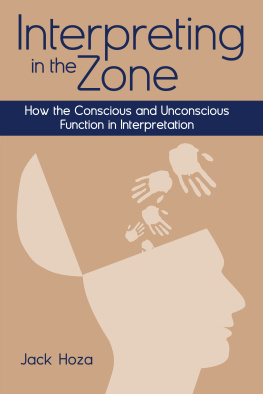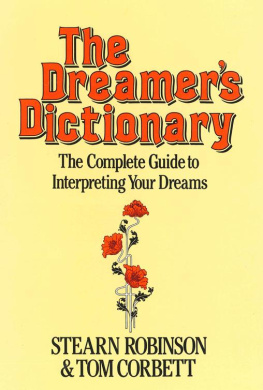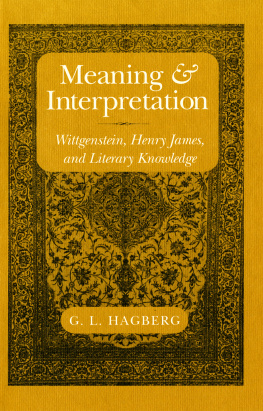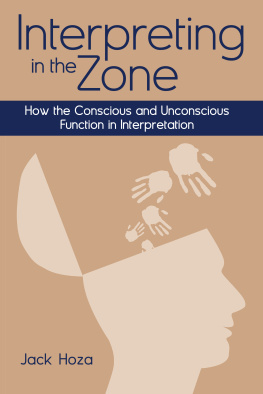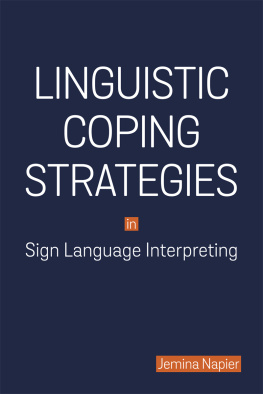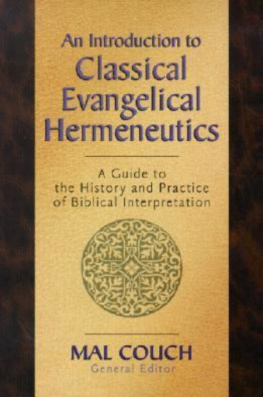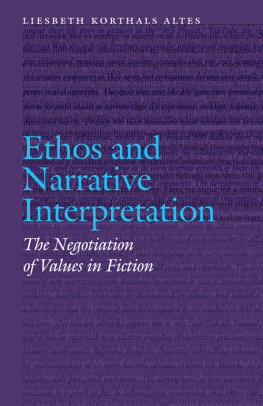I NTERPRETING IN THE Z ONE
I NTERPRETING IN THE Z ONE
How the Conscious and Unconscious Function in Interpretation
Jack Hoza
Gallaudet University Press
WASHINGTON, DC
Gallaudet University Press
Washington, DC 20002
http://gupress.gallaudet.edu
2016 by Gallaudet University
All rights reserved. Published 2016
Library of Congress Cataloging-in-Publication Data
Names: Hoza, Jack, author.
Title: Interpreting in the zone : how the conscious and unconscious function in interpretation / Jack Hoza.
Description: Washington, DC : Gallaudet University Press, [2016] | Description based on print version record and CIP data provided by publisher; resource not viewed.
Identifiers: LCCN 2016017341 (print) | LCCN 2016002622 (ebook) | ISBN 9781563686672 (ebook) | ISBN 9781563686665 (hardback)
Subjects: LCSH: Simultaneous interpretingPsychological aspects. | Translating and interpretingPsychological aspects. | Psycholinguistics. | BISAC: LANGUAGE ARTS & DISCIPLINES / Translating & Interpreting. Classification: LCC P306.95 (print) | LCC P306.95 .H69 2016 (ebook) | DDC 418/.02dc23
LC record available at https://lccn.loc.gov/2016017341
Cover graphicFile404/123RF.com
In memory of my brother
Timothy R. Hoza
who left us too early
Life begins at the end of your comfort zone.
Neale Donald Walsch
C ONTENTS
Interpreting in the Zone provides an in-depth treatment of how interpreters manage the interpreting process and make interpreting-related decisions. Specifically, the book explores how interpreters can get in the zone (i.e., those moments when they do their best work) and how the conscious and unconscious function in interpretation. In addition, the book covers how the conscious and unconscious affect ones interactions with others and can either advance or inhibit ones professional growth. Given the specialized nature of the books topics, I introduce myself to you in this preface, so that you can have a better sense of my experience as an American Sign Language (ASL)/English bilingual, my development as an interpreter, my professional background, and my reasons for writing the book.
I am a (hearing) native ASL/English bilingual, born to Deaf parents, and of my seven siblings, two brothers are Deaf. My first experiences interpreting occurred when I was asked to take on that role by Deaf family members and Deaf friends. Even though I was the sixth of eight children and not the oldest child (the one who usually becomes the family interpreter in bilingual homes), I was seen as the family interpreter. However, I only interpreted occasionally when I was growing up, because my parents usually preferred to communicate on their own with hearing people by using gestures or written English. When I did interpret, I interpreted consecutively, because I wanted to make sure I understood what was intended before constructing meaning in the other language. The first time I attempted simultaneous interpretation was during my freshman year in college when I was hired to interpret classes (this was in the days before stricter rules about who could work in the interpreting field). I remember thinking, Oh, you want me to keep up?
I chalk up my professional development to three primary factors: the support and mentorship of many Deaf people and allied hearing people over the years, my academic exploration of interpreting, and the fact that ASL and English have always been separate in my mind. That is, I did not mix the languages by engaging in simultaneous communication (sim-com); in fact, I did not start talking and signing at the same time until I was in college. I consider simultaneous interpretation to be an advanced cognitive process that is heavily dependent on ones intuitive ability to construct meaning quickly and to have an instinctive ability to go for meaning and, at the same time, manage to keep up, which compose the real challenges of this mode of interpreting. Unlike sim-com, which artificially superimposes the lexicon and linguistic structures of the two languages, simultaneous interpretation, like consecutive interpretation, focuses on communicating effectively by using two separate, complete languages.
The two primary reasons why I wrote this book were my own interest in researching the interpreting process and my desire to report on major advances in the field. I wish I had this type of book when I was starting out as an interpreter or when I was working more steadily as an interpreter.
I have always been curious about how interpreters think about their work and how they manage to construct meaning in a second, or third, language. I have seen interpreters who interpreted what someone said only to have the other party feel insulted, even though that was not the persons intent. I have seen Deaf people struggle to follow the signed target language output of an interpreter, because it came across as literal or incoherent, yet the interpreter seemed unaware of the Deaf persons difficulty comprehending. I have also seen interpreters who consistently put the participants first, speak up when confusion occurs during interpretation, and seek to remedy any issues. What I have always strived to understand is, What were they thinking at the time? This book is the result of trying to understand the thinking processes of a variety of interpreters when they engage in interpretation, interact with participants, and make professional and ethical decisions. Interpreting in the Zone is the result of exploring that question over a period of several years and provides insight into how interpreters can enhance their own interpreting work and associated professional and ethical decision-making.
Professionally, I am a professor and director of the baccalaureate degree program in ASL/English Interpreting at the University of New Hampshire, Manchester campus (UNH Manchester) and have worked as an interpreter and interpreter educator for several decades. I am honored to have received a UNH Faculty Scholars Award and the UNH Manchester Excellence in Teaching Award. My research interests include team interpreting, linguistic politeness in ASL and English, the professional and ethical decision-making process of interpreters, how interpreters get in the zone, and how the unconscious and conscious work when the interpreter is in the zone. In addition to writing this volume, I am the author of Team Interpreting as Collaboration and Interdependence (RID Press), Its Not What You Sign, Its How You Sign It: Politeness in American Sign Language (Gallaudet University Press), and The Interpreters Guide to Life: 365 Tips for Interpreters (Sign Media, Inc.).
I hold a Ph.D. in Applied Linguistics from Boston University and a masters degree in Teaching Interpreting from McDaniel College. A fully certified interpreter, I hold the Comprehensive Skills Certificate (CSC), Certificate of Interpretation (CI), and Certificate of Transliteration (CT) from the Registry of Interpreters for the Deaf (RID).
I was inspired to write this book by the many discussions about interpreting that I have had over the years with Deaf people, interpreters, interpreting students, and fellow interpreter educators. Many of these discussions centered on what interpreters are thinking when doing their work. This book and my own research would not have been possible without these many thought-provoking conversations.
I am thankful to those who were involved in bringing this book to publication. It began with the University of New Hampshire, which provided funds to support the research and granted me a Faculty Scholars Award that allowed me to have a paid leave of absence to finish the manuscript. The support of the faculty and administration has been tremendous.

